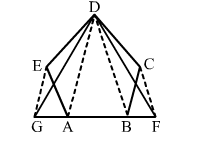The given figure shows a pentagon ABCDE. EG, drawn parallel to DA, meets BA produced at G, and CF, drawn parallel to DB, meets AB produced at F.
The given figure shows a pentagon ABCDE. EG, drawn parallel to DA, meets BA produced at G, and CF, drawn parallel to DB, meets AB produced at F. Show that ar(pentagon ABCDE) = ar(∆DGF).

Given: ABCDE is a pentagon. EG || DA and CF || DB.
To prove: ar(pentagon ABCDE ) = ar( ∆DGF)
Proof:
ar(pentagon ABCDE ) = ar(∆DBC) + ar(∆ADE ) + ar(∆ABD) ...(i)
Also, ar(∆DGF) = ar(∆DBF) + ar(∆ADG) + ar(∆ABD ) ...(ii)
Now, ∆DBC and ∆DBF lie on the same base and between the same parallel lines.
∴ ar(∆DBC) = ar(∆DBF) ...(iii)
Similarly, ∆ADE and ∆ADG lie on same base and between the same parallel lines.
∴ ar(∆ADE) = ar(∆ADG) ...(iv)
From (iii) and (iv), we have:
ar(∆DBC) + ar(∆ADE) = ar(∆DBF) + ar(∆ADG)
Adding ar(∆ABD) on both sides, we get:
ar(∆DBC) + ar(∆ADE) + ar(∆ABD) = ar (∆DBF) + ar(∆ADG) + ar(∆ABD)
By substituting the values from (i) and (ii), we get:
ar(pentagon ABCDE) = ar(∆DGF)
